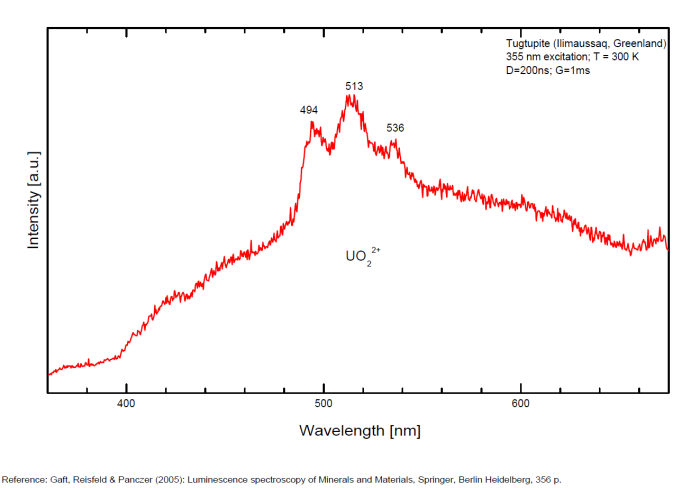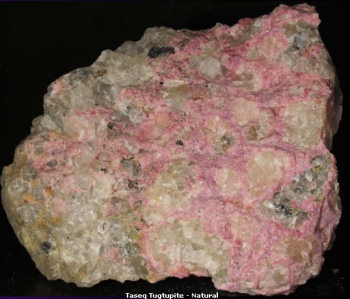Database of luminescent minerals
TUGTUPITE
Chemical formula: Na4AlBeSi4O12Cl
Family: Silicates
Status: IMA-GP
Crystal system : Tetragonal
Display mineral: OUI
Associated names (luminescent varieties, discredited names, synonyms, etc.): tugtulite,
Luminescence:
Longwave UV (365nm) colors: |
Orange , Pinkish White , Orange Red , Red , Salmon pink , | ||
Midwave UV (320nm) colors: |
Pinkish White , Orange , Pink , | ||
Shortwave UV (254nm) colors: |
Orange Red , Yellowish White , Pinkish White , Orange , Red , | ||
Daylight picture
Longwave (365nm) picture
Midwave (330nm) picture
Shortwave (254nm) picture
Do you have a photo of this mineral you would like to see in the gallery? Contact us!
Phosphorescence (in the common sense of the term) observable with the naked eye:
Type d'UV |
Couleur |
Intensité |
Fréquence d'observation |
|---|---|---|---|
UV longs (365nm): | Pinkish White | Medium | UV moyens (320 nm): | Bluish White | Medium | UV courts (254 nm): | Bluish White | Medium |
Tenebrescence: OUI

Activator(s) and spectrum:
Activator(s): S2-, Fe3+, Eu2+, Ce3+, Mn2+ ,
Peaks in the spectrum (nm):
S2- : band with weak vibrational structure peaking at 600-680nm Fe3+repl. Si4+ : 570 - 680nm

Col. G. Barmarin; Spectre: G. Barmarin
Spectrum Galery:


 ...
...Comments on spectrum and activators:
It is generally accepted that the yellow-orange emission of tugtupite with weak vibrational structure at 300 K, which becomes more prominent at low temperatures, is connected to a S2- luminescence center (Povarennykh et al. 1971). Laser-induced time-resolved technique enables Gaft to detect Eu2+ (Band at 430nm) and Ce3+ (Band at 360nm), two different Mn2+ (Band at 495 & 512nm), Fe3+ (Band at 670nm) and S2- (Band at 603nm) emission centers.
Best localities for fluorescence (*):
- Ilimaussaq complex, Kvanefjeld, Narsaq, Kitaa (West Greenland) Province, Greenland;
- Ilimaussaq complex, Taseq slopes, Narsaq, Kitaa (West Greenland) Province, Greenland;
- Ilimaussaq complex, Kangerlassaq, Narsaq, Kitaa (West Greenland) Province, Greenland;
- Poudrette quarry, Mont Saint-Hilaire, La Vallée-du-Richelieu RCM, Montérégie, Québec, Canada;
- Shkatulka pegmatite, Umbozero mine, Alluaiv Mt, Lovozersky District, Murmansk Oblast, Russia;
(*)The data are not exhaustive and are limited to a few remarkable localities for fluorescence
Bibliographic reference for luminescence:
- The Henkel Glossary of Fluorescent Minerals, Dr. Gerhard Henkel, Published by the FMS, 1989 ,
- Fluorescence: Gems and Minerals Under Ultraviolet Light, Manuel Robbins, 1994, Geoscience Press, ISBN 0-945005-13-X ,
- The World of Fluorescent Minerals, Stuart Schneider, Schiffer Publishing, 2006, ISBN 0-7643-2544-2 ,
- Luminescence Spectroscopy of Minerals and Materials, M. Gaft, R. Reisfeld, G. Panczer, Springer Editor, ISBN: 10 3-540-21918-8 ,
- Mt St Hilaire Website: http://www.saint-hilaire.ca ,
- Minershop.com ,
Reference for luminescence on the Internet:
- Fluorescent minerals of Greenland from The Minershop:
- www.minershop.com/FLmingreen.pdf (Pdf,1,54 Mb)
- www.minershop.com/history.pdf (Pdf, 22Mb)
- Fluorescent minerals of Greenland from The Minershop
- Handbook of mineralogy
- https://www.academia.edu/21548029/Laser-induced_time-resolved_luminescence_of_tugtupite_sodalite_and_hackmanite
- MONT-SAINT-HILAIRE, History, Geology, Mineralogy, Laszlo HORVATH, The Canadian Mineralogist, Special Publication 14, 2019
Images:
- Shkatulka pegmatite, Umbozero mine,Russia: https://www.mindat.org/photo-66915.html
- Kvanefjeld, Ilímaussaq complex, Greenland: https://www.mindat.org/photo-68220.html
Videos:
- Ténébrescence hackmanite & tugtupite : https://www.youtube.com/watch?v=stDh8GDkEYc
Mineralogical reference on the Internet:
 http://www.mindat.org/show.php?name=Tugtupite
http://www.mindat.org/show.php?name=Tugtupite
 http://webmineral.com/data/Tugtupite.shtml
http://webmineral.com/data/Tugtupite.shtml
Internet Search:
 Image search on 'Google Images'
Image search on 'Google Images'
 Search for documents in all languages on Google
Search for documents in all languages on Google
A request providing no result means only that no such reference exists in the database, but it does not mean that what you are looking for does not exist, just not to our knowledge. If you think you have found an error or omission, please let us know via the contact page being sure to cite the source of information.





